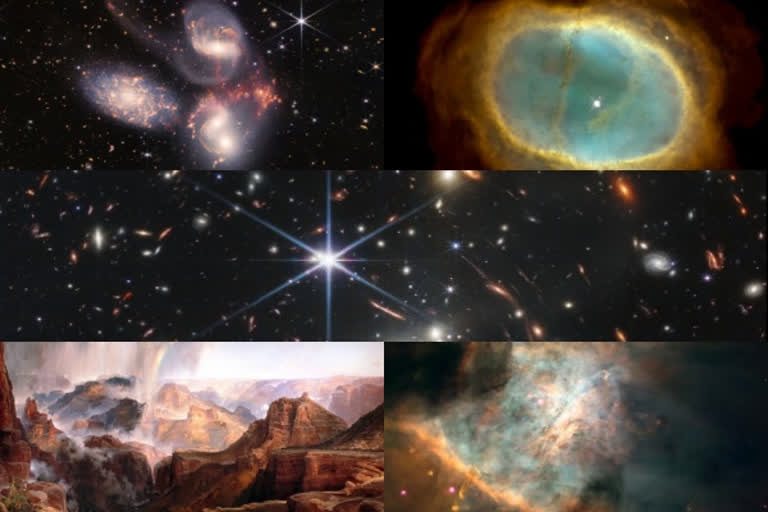Stanford (USA): A cosmologist, cultural historian, and neurosurgeon discuss how outer space and otherworldly phenomena can inspire discovery across disciplines and bring people together at Stanford University. The images to emerge from the James Webb Space Telescope have captured details of the cosmos never seen before, leaving the scientific community and public alike in a state of awe.
In a Tweet, former President Barack Obama described them as “mind-blowing.” Even Stanford cosmologist Zeeshan Ahmed, for whom such images are commonplace, admitted: “You can’t contain it in your head. I think this is true for everybody – I mean, scientists are human still.” NASA’s James Webb Space Telescope has been able to show new, finer details of the galaxy group, Stephan’s Quintet. The rendering here was created from nearly 1,000 separate image files.
“Awe is sort of this ineffable sense of transcendence,” said Stanford neurosurgeon and compassion scholar James Doty. “In some ways, you melt into it.” Scholars across disciplines have long sought to understand the stirring – soul searching, even – emotions the universe evokes. Some have described a shakiness they call “cosmic vertigo.” Others have used the term “cosmic insignificance” when confronted with one’s littleness in a limitless universe. A few have found dwelling too long on such thoughts to be anxiety-inducing, an experience they label “neuroexistentialism.”
To describe how images from outer space can excite and expand the human mind, Stanford advanced lecturer in American studies Elizabeth Kessler, who studies the visual culture of astronomy, has found it useful to draw on the sublime, an aesthetic concept that the eighteenth-century philosopher Immanuel Kant associated with natural phenomena of vast size, scale, or power, such soaring mountains, deep abysses, plunging waterfalls, and the star-filled sky in trying to understand the emotions evoked in himself by the Milky Way and the starry heavens. For Kant, the experience of such immensity overwhelmed the senses, but human reason could transcend those limits, which made it an affirming experience that expanded knowledge and understanding.
Bigger and beyond: A casual stroll across the university campus is enough to reveal the extent to which the universe can serve as a muse. At Stanford, representations of outer space can be found beyond the research labs and classrooms of astrophysicists and cosmologists. Walk across the Engineering Quad Courtyard and one will encounter Alicja Kwade’s installation, Pars pro Toto, 12 human-sized stone planetary orbs that combine the geological with the cosmological to inspire new ways of thinking about the world.
At the Cantor Arts Center, a cast of Auguste Rodin’s iconic thinker shines under the fluorescent glow of Spencer Finch’s representation of the exploding Betelgeuse star. Wrapping the staircase to the David Rumsey Map Center at Green Library are reproductions of 17th-century star and constellation maps, beautifully blown up to emphasize figures from Greek mythology amid celestial heavens – all reminders of humanity’s place in the world and our connections to each other.
For James Doty, who is also the founder and director of the Stanford Center for Compassion and Altruism Research and Education, of which His Holiness the Dalai Lama is the founding benefactor, awe’s power lies in its ability to make us feel connected to something much larger than ourselves. “At the end of the day, we are all one, not only with each other but with every living being and in fact, with the universe,” Doty said.
“The very nature of thinking about that, and understanding you are the part of this extraordinary thing that is going on around us, creates this deep sense of purpose and connection, and in some ways, happiness.” The transcendent experience of self-realization and oneness is also the basis of many religions, Doty points out. For example in Buddhism, there is a deep desire to attain enlightenment, which ultimately is about merging oneself with the universe.
Designed to inspire: According to Elizabeth Kessler, the art historian, who has examined the parallels between art and philosophy and astronomical images in her book, Picturing the Cosmos: Hubble Space Telescope Images and the Astronomical Sublime (University of Minnesota Press, 2012), astronomical images are crafted in a way to represent scientific data and evoke an aesthetic response.
As Kessler learned in her interviews with the team that produced images for the Hubble Heritage Project, NASA wanted to circulate imagery that would inspire the general public, not just individuals working in science and technology. Like any representation, every astronomical image involves decisions about how to depict celestial phenomena captured by the telescope in a way that won’t feel strange to audiences. “Astronomers and image processors carefully balance the need for a scientifically valid image with the desire for an aesthetically compelling one,” said Kessler.
Because telescopes collect data too faint for our eyes to see and beyond the visible light spectrum (JWST primarily in infrared light, Hubble in visible and ultraviolet), their images are assigned colors in order for us to appreciate them more fully. Every color picture from JWST, for example, is actually a composite of at least three different monochrome images, each one collected using a filter that captures a different wavelength of infrared light. Exposures can last hours or even days. Each filter is then assigned a different color, which is combined into the final images that get circulated.
While any color can be mapped onto any wavelength, astronomers believe some color combinations work better than others. For example, in the Hubble Heritage Project’s early rendition of the planetary nebula NGC 3132, the team experimented with an unconventional color scheme of pinks and yellows. But the end result “didn’t feel right,” said astronomer Keith Noll in an interview with Kessler, so they used colors less strange and more typical of terrestrial worlds.
